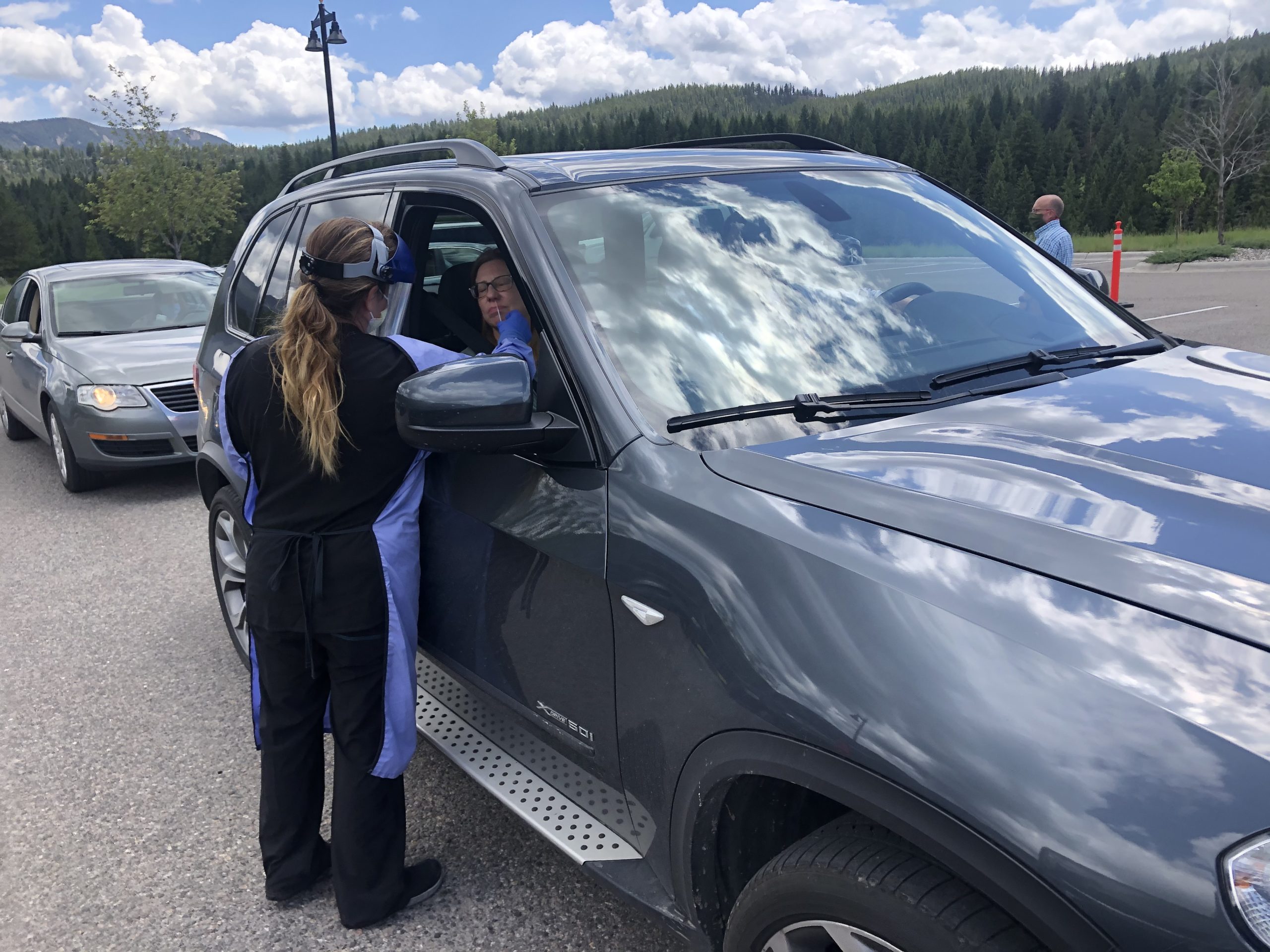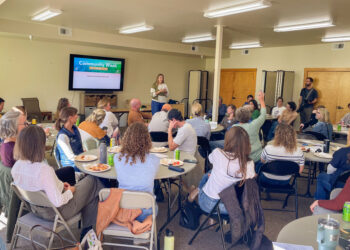As national shortage creates lag, 27 percent of test results received from July 1 test
By Bella Butler and Brandon Walker EBS STAFF
Editor’s note: This story was updated at 4 p.m. on July 20 to clarify testing prioritization at the Montana Public Health Laboratory.
BIG SKY – Nearly three weeks after approximately 700 COVID-19 tests were administered at the Bozeman Health Big Sky Medical Center, only 187 results have been received and one was confirmed positive for the virus. According to test event hosts, the prolonged delay in response time is a reflection of national testing capacity shortfalls.
On July 1, a partnership between Bozeman Health and Big Sky Resort Area District, as well as the Gallatin City-County and Madison County health departments, hosted a surveillance test at BSMC. For eight hours, cars lined up and filtered through two parking lot test sites, where nasal swab tests were administered free of up-front costs to individuals.
Those who were tested opted for either digital or physical mail notification of their results, which Bozeman Health said at the time of testing would be delivered in seven to 10 days. While many are still waiting for results, Bozeman Health said it can’t guarantee a timeline at this point.
In a July 15 statement, Bozeman Health officials said they had been assured by the state that results would be available within three to five days of specimen collection. They gave participants the seven- to 10-day estimation to best manage expectations and prepare for the unexpected, according to Bozeman Health’s Chief Advancement Officer Jason Smith.
To make arrangements for Big Sky’s surveillance testing, Bozeman Health and BSRAD consulted with a COVID-specific state task force, which directly receives testing resources from the federal government, in order to implement the program locally.
In mid-April, Gov. Steve Bullock created Montana’s Coronavirus Relief Fund Task Force, an initiative aimed at providing guidance for how to distribute the $1.25 billion appropriated to Montana through the CARES Act. Through the task force, Bozeman Health secured funding for testing materials, supplies and PPE for test event staff from the state’s Community Snapshot program. The program pairs communities and businesses with widespread, asymptomatic testing opportunities to provide a “community-level early warning system.”
Currently, the Department of Health and Human Services has classified procession prioritization at the Montana Public Health Laboratory. Priority 1 tests are those of symptomatic individuals and close contacts of known cases. Front-line workers and residents of selected congregate settings such as group homes are classified as Priority 2, and other testing such as asymptomatic surveillance testing are of low priority.
Given the increasing quantity of tests needed as COVID-19 cases rise and testing efforts expand, the state lab has been redistributing surveillance COVID-19 tests to other private labs when they are received. Specimens from the July 1 Big Sky testing event were sent to Quest Diagnostics, an international diagnostic laboratory that is processing COVID-19 tests in the U.S. At press time, Quest had not responded to EBS requests for information about which of its labs was testing the Big Sky samples, and had not provided a timeline for processing the remaining results.
According to Quest’s website, the company processed 3.15 million active infection tests sourced from around the U.S. from March 9 to June 1. “At the peak of the crisis,” its website states, “Quest lab services accounted for nearly half of all COVID-19 testing across the U.S.”
But as recent spikes in COVID-19 have swept across the country and testing demand soars, supply chains are suffering. So is Montana. In an email to EBS, the state’s Disaster and Emergency Services agency said delays in test results are due in part to transport times.
“Our goal with Quest was three to five days from when [the] lab received the sample,” the email said. “However, it can take the lab several days to receive the sample after the sample has been collected. This additional time should be factored in when considering the amount of time between when the test is performed to when the patient receives results back.” The statement said this information was communicated to all Community Snapshot event hosts in Montana.
According to Quest, the real delay is because of an increase in coronavirus infections and the resulting increase in testing.
In a statement EBS received from Quest, rising COVID-19 rates in certain regions, including the West, created a backlog in processing tests expanding the three- to five-day turnaround time to an average of seven days for non-priority patients. While Quest is still accepting specimens, the company is asking healthcare providers to abide by its prioritization plan and limit the number of low-risk sample submissions.
“This is not just a Quest issue,” the statement said. “The surge in COVID-19 cases affects the laboratory industry as a whole.”
During a July 15 press conference, Gov. Steve Bullock pointed to an insufficient federal approach to testing that’s now impacting states and labs that are becoming overrun.
“I’m deeply concerned in the lack in what I think is a national testing strategy from the federal government,” Bullock said. “When it takes a week to 10 days or more to provide us results back on our tests, it really is of more limited value to Montanans.”
Citing a Harvard Global Health Institute study that named Montana as one of nine states providing adequate testing, Bullock said Montana is seeing success in improving testing capacity though it’s unclear whether the state will be able to perform all the Community Snapshot testing events it has planned.
The lag in Big Sky’s test response times is not an isolated occurrence. A Yellowstone Public Radio story from July 16 said that extended wait times are a circumstance of most asymptomatic testing in the state. YPR reported that as of July 15, Lincoln County was still awaiting 900 results from a testing event on July 6.
Careen Little is among 507 people still awaiting results from the July 1 testing event in Big Sky. “I don’t want to disrespect the intention but I am definitely frustrated,” she wrote in a message to EBS. “I am glad that there was some recognition brought to a very disappointing experience.”
Smith said that, had Bozeman Health been aware of the two-week-plus turnaround time, it would not have pressed forward with the Big Sky surveillance testing.
Smith added that pilot surveillance testing programs should be evaluated based on three considerations: the operational success and efficiency of collecting test specimens, the expediency and accuracy at which results are received and relayed, and the impact that the results then have within the community.
“Pilot programs are not implemented with the idea that we’ll determine whether they are successful or unsuccessful,” Smith said. “It’s important to grow and innovate and try things that we believe will have an impact on patients and the public.”
Smith said the collection process was successful but recognized the test response time needed to improve. Others, however, stated that the delay undermines the test itself.
“… To have those specimens gathered [and] then not get the results for such a period of time is disappointing and it really poses pretty significant challenges to the usefulness of any of that testing,” said Gallatin City-County Health Officer Matt Kelley, adding that after nearly three weeks from when tests were conducted in Big Sky, positive tests are likely no longer transmissible.
“Outside of that 10 days the utility of reducing disease spread goes down pretty dramatically and that’s a big problem with having the national pipeline pretty full right now,” he said.
BSRAD board chair Kevin Germain expressed a similar concern. “Obviously we’re extremely disappointed that it’s taken over two weeks and realize that because of the delay it’s really futile in trying to stop the spread of COVID in our community,” he said in a July 17 interview.
Given the potential inefficacy of the surveillance test, a model that BSRAD was hoping to continue in Big Sky, the resort district has now shifted its focus to acquiring test kits that can be processed locally at Bozeman Health Big Sky Medical Center and Bozeman Health Deaconess Hospital.
Bozeman Health Deaconess possesses a Hologic Panther analyzer that has the capacity to process approximately 1,000 COVID-19 tests per day. BSMC has a Cepheid analyzing machine, purchased with Big Sky Relief funds, that is capable of processing two COVID-19 tests per hour, according to Germain. But BSMC does not have the test kits needed for the machine to perform testing.
In an effort to acquire the test kits, 11 local and regional leaders, including Kelley and Germain, signed a letter dated July 6 that was sent to Montana Sens. Steve Daines and Jon Tester as well as state congressional representative Greg Gianforte.
“We need your immediate support of increasing Montana’s Panther and Cepheid testing kit supply,” the letter stated, “helping to procure the ventilators we ordered in April, and CARES funding to endorse our testing plan thus supporting the health and safety of our most valuable winter economy—Southwest Montana.”
Although frustrated by the lengthy delay in processing his test, Big Sky local Ryan Wilson said he would support another surveillance testing attempt if results were able to be processed in a timely manner. “I would like to see another round of testing with a better commitment on turnaround,” he said.
Many parties in the Big Sky community, including BSRAD and the Big Sky Medical Center, are urging for increased testing efforts, but only if the tests will be processed in a reasonable amount of time.
“If we can ensure the availability of testing supplies and if we can be certain that test results will be received in a much faster way, we would like to be able to do additional surveillance testing in Big Sky and across our broader region in the future,” Smith said.
The main benefit of efficient surveillance testing, according to Smith, would be allowing asymptomatic individuals to know if they are infected and be able to take the necessary measures to reduce further virus spread. He added that sentinel testing for employees is another promising method to keeping businesses open.
But as COVID-19 cases rise and until supply chains throughout the federal government, state agencies and healthcare providers can confidently assure that test results will be returned in a reasonable amount of time, Smith says don’t expect further surveillance testing anytime soon.
“Unless and until Bozeman Health and Big Sky Medical Center have a high degree of confidence that samples can be collected and … test results can be received quickly, we are unlikely to embark on this,” Smith said.
Test-result numbers reflect the most current information available at the time of publication. Bozeman Health is notifying individuals of test results as they are returned.













